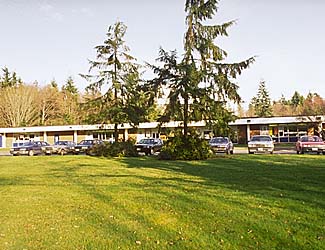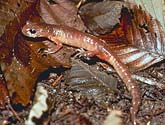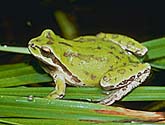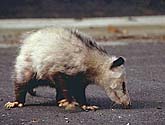
Home |
About Us |
How to Participate |
Biodiversity Modules |
Projects |
Maps |
News |
Resources

Home |
About Us |
How to Participate |
Biodiversity Modules |
Projects |
Maps |
News |
Resources
|
Definition of "Developed" - General Code 200: Significant human influence. Surface development includes buildings, pavement, etc. Excludes agricultural land and clear cuts. |
Developed: Low Density Residential (231)

| |
| Descriptive Habitat Code: This schoolyard is "developed" (2) has more vegetation (>75%) than development (3) and is in a residential (1) neighborhood. | |
| Photo: KMD | |
 Ensatina Ensatina eschsholtzi Code:ENES Photo: WDFW |
Distribution and Habitat: It is found under bark, logs and rocks in coniferous and deciduous forests; both in open and wooded settings. Diet: Interesting fact: |
 Coyote Canis latrans Code: CALAT |
Distribution and Habitat: It is found in mountainous areas, grasslands, deciduous and mixed coniferous forests and even urban areas. Diet: Interesting fact: |
 Eastern gray squirrel Sciurus carolinensis Code: SCCA Photo: KMD |
Distribution and Habitat: It is found throughout deciduous woodland areas of North America as well as being a common inhabitant of developed areas of towns, cities, residential and even industrial areas. Diet: Interesting fact: |
 House sparrow Passer domesticus Code: PADO Photo: RA |
Distribution and Habitat: It is native to Europe and was introduced into the United States in 1850 where it has become a permanent fixture in developed areas. Diet: Interesting fact: |
 Long-toed salamander Ambystoma macrodactylum Code: AMMA Photo: WDFW |
Distribution and Habitat: It is found in semi-dry sagebrush areas, rocky shores of lakes, alpine meadows, and even developed areas, in rotting wood and under rocks near lakes, ponds, wetlands and other areas of standing water. Diet: Interesting
fact: |
 Pacific tree frog Hyla regilla Code:PSRE Photo: WDFW |
Distribution and Habitat: It is found throughout the Pacific Northwest, never too far from small ponds. Diet: Interesting fact: |
 Raccoon Procyon lotor Code: PRLO Photo: KMD |
Distribution and Habitat: It is native throughout most of the United States and southern Canada, but has also been introduced into Europe and Asia. It is a common inhabitant of agricultural and residential areas. Diet:
Interesting fact: |
 Red-winged blackbird Agelaius phoeniceus Code: AGPH Photo: RA |
Distribution and Habitat: It is found in wetland areas. Diet: Interesting fact: |
 Steller's jay Cyanocitta stellari Code: CYST Photo: RA |
Distribution and Habitat: It is found throughout conifer forests and developed areas with large trees. Diet: Interesting fact: |
 Sharp-shinned hawk Accipiter striatus Code: ACST Photo: RA |
Distribution and Habitat: It is found throughout North America from Alaska and Canada southward to Panama. It is a neo-tropical migrant. Diet: Interesting fact: |
 Virginia oposum Didelphis virginiana Code: DIVI Photo: RA |
Distribution and Habitat: It is found in a wide variety of habitats, including temperate and tropical forests, mountains, grasslands and urban (developed) settings. Diet: Interesting fact: |
Home |
About Us |
How to Participate |
Biodiversity Modules |
Projects |
Maps |
News |
Resources